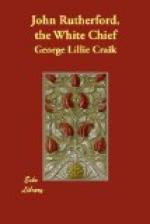The old woman’s daughter, who had come along with her, then made her approach, and another scene, if possible of still more tumultuous tenderness than the former, took place between the two cousins. The chief hung, as before, in an agony of affection, on the neck of his relation; and “as for the woman,” says Nicholas, “she was so affected that the mat she wore was literally soaked through with her tears.” A passionate attachment to friends is, indeed, one of the most prevailing feelings of the savage state. Dampier tells us of an Indian who recovered his friend unexpectedly on the island of Juan Fernandez, and who immediately prostrated himself on the ground at his feet. “We stood gazing in silence,” says the manly sailor, “at this tender scene.”
The house of the chief to which Rutherford and his comrades were taken was the largest in the village, being both long and wide, although very low, and having no other entrance than an aperture, which was shut by means of a sliding door, and was so much lower even than the roof that it was necessary to crawl upon the hands and knees to get through it.
Two large pigs and a quantity of potatoes were now cooked; and when they were ready, a portion having been allotted to the slaves, who are never permitted to eat along with the chiefs, the latter sat down to their repast, the white men taking their places beside them.
The feast was not held within the house, but in the open air; and the meat that was not consumed was hung up on posts for a future occasion. One of the strongest prejudices of the New Zealanders is an aversion to be where any article of food is suspended over their heads; and on this account, they never permit anything eatable to be brought within their huts, but take all their meals out of doors, in an open space adjoining to the house, which has been called by some writers the kitchen, it being there that the meal is cooked as well as eaten. Crozet says that every one of these kitchens has in it a cooking hole, dug in the ground, of about two feet in diameter, and between one and two feet deep. Even when the natives are confined to their beds by sickness, and, it may be, at the point of death, they must receive whatever food they take in this outer room, which, however, is sometimes provided with a shed, supported upon posts, although in no case does it appear to be enclosed by walls. It is here, accordingly, that those who are in so weak a state from illness as not to be able to bear removal from one place to another usually have their couches spread; as, were they to choose to recline inside the house, it would be necessary to leave them to die of want.
Nicholas, in the course of an excursion which he made in the neighbourhood of the Bay of Islands, was once not a little annoyed and put out of humour by this absurd superstition. It rained heavily when he and Marsden arrived very hungry at a village belonging to a chief of their acquaintance, where, although the chief was not at home, they were very hospitably received, their friends proceeding immediately to dress some potatoes to make them a dinner. But after they had prepared the meal, they insisted, as usual, that it should be eaten in the open air.




